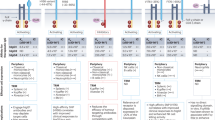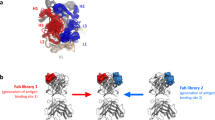Abstract
Two humanized IgG4 antibodies, natalizumab and gemtuzumab, are approved for human use, and several others, like TGN1412, are or have been in clinical development. Although IgG4 antibodies can dynamically exchange half-molecules1, Fab-arm exchange with therapeutic antibodies has not been demonstrated in humans. Here, we show that natalizumab exchanges Fab arms with endogenous human IgG4 in natalizumab-treated individuals. Gemtuzumab, in contrast, contains an IgG4 core-hinge mutation that blocks Fab-arm exchange to undetectable levels both in vitro and in a mouse model. The ability of IgG4 therapeutics to recombine with endogenous IgG4 may affect their pharmacokinetics and pharmacodynamics. Although pharmacokinetic modeling lessens concerns about undesired cross-linking under normal conditions, unpredictability remains and mutations that completely prevent Fab-arm exchange in vivo should be considered when designing therapeutic IgG4 antibodies.
This is a preview of subscription content, access via your institution
Access options
Subscribe to this journal
Receive 12 print issues and online access
$209.00 per year
only $17.42 per issue
Buy this article
- Purchase on Springer Link
- Instant access to full article PDF
Prices may be subject to local taxes which are calculated during checkout



Similar content being viewed by others
References
van der Neut Kolfschoten, M. et al. Anti-inflammatory activity of human IgG4 antibodies by dynamic Fab arm exchange. Science 317, 1554–1557 (2007).
Labrijn, A.F., Aalberse, R.C. & Schuurman, J. When binding is enough: nonactivating antibody formats. Curr. Opin. Immunol. 20, 479–485 (2008).
Reddy, M.P. et al. Elimination of Fc receptor-dependent effector functions of a modified IgG4 monoclonal antibody to human CD4. J. Immunol. 164, 1925–1933 (2000).
Newman, R. et al. Modification of the Fc region of a primatized IgG antibody to human CD4 retains its ability to modulate CD4 receptors but does not deplete CD4(+) T cells in chimpanzees. Clin. Immunol. 98, 164–174 (2001).
Angal, S. et al. A single amino acid substitution abolishes the heterogeneity of chimeric mouse/human (IgG4) antibody. Mol. Immunol. 30, 105–108 (1993).
Bloom, J.W., Madanat, M.S., Marriott, D., Wong, T. & Chan, S.Y. Intrachain disulfide bond in the core hinge region of human IgG4. Protein Sci. 6, 407–415 (1997).
Schuurman, J., Perdok, G.J., Gorter, A.D. & Aalberse, R.C. The inter-heavy chain disulfide bonds of IgG4 are in equilibrium with intra-chain disulfide bonds. Mol. Immunol. 38, 1–8 (2001).
Yednock, T.A. et al. Prevention of experimental autoimmune encephalomyelitis by antibodies against alpha 4 beta 1 integrin. Nature 356, 63–66 (1992).
Sievers, E.L. et al. Selective ablation of acute myeloid leukemia using antibody-targeted chemotherapy: a phase I study of an anti-CD33 calicheamicin immunoconjugate. Blood 93, 3678–3684 (1999).
Polman, C.H. et al. A randomized, placebo-controlled trial of natalizumab for relapsing multiple sclerosis. N. Engl. J. Med. 354, 899–910 (2006).
Bross, P.F. et al. Approval summary: gemtuzumab ozogamicin in relapsed acute myeloid leukemia. Clin. Cancer Res. 7, 1490–1496 (2001).
Salfeld, J.G. Isotype selection in antibody engineering. Nat. Biotechnol. 25, 1369–1372 (2007).
Hanke, T. Use of an active substance binding to CD28 for producing a pharmaceutical composition for the treatment of B-CLL. US patent application 20070122410 (2007).
Suntharalingam, G. et al. Cytokine storm in a phase 1 trial of the anti-CD28 monoclonal antibody TGN1412. N. Engl. J. Med. 355, 1018–1028 (2006).
Bleeker, W.K. et al. Dual mode of action of a human anti-epidermal growth factor receptor monoclonal antibody for cancer therapy. J. Immunol. 173, 4699–4707 (2004).
Teeling, J.L. et al. Characterization of new human CD20 monoclonal antibodies with potent cytolytic activity against non-Hodgkin lymphomas. Blood 104, 1793–1800 (2004).
Aucouturier, P. & Preud'Homme, J.L. Subclass distribution of human myeloma proteins as determined with monoclonal antibodies. Immunol. Lett. 16, 55–57 (1987).
Gordon, F.H. et al. A randomized placebo-controlled trial of a humanized monoclonal antibody to alpha4 integrin in active Crohn's disease. Gastroenterology 121, 268–274 (2001).
Sheremata, W.A., Vollmer, T.L., Stone, L.A., Willmer-Hulme, A.J. & Koller, M. A safety and pharmacokinetic study of intravenous natalizumab in patients with MS. Neurology 52, 1072–1074 (1999).
Burton, D.R. & Wilson, I.A. Immunology. Square-dancing antibodies. Science 317, 1507–1508 (2007).
Langer-Gould, A., Atlas, S.W., Green, A.J., Bollen, A.W. & Pelletier, D. Progressive multifocal leukoencephalopathy in a patient treated with natalizumab. N. Engl. J. Med. 353, 375–381 (2005).
Kleinschmidt-DeMasters, B.K. & Tyler, K.L. Progressive multifocal leukoencephalopathy complicating treatment with natalizumab and interferon beta-1a for multiple sclerosis. N. Engl. J. Med. 353, 369–374 (2005).
Van Assche, G. et al. Progressive multifocal leukoencephalopathy after natalizumab therapy for Crohn's disease. N. Engl. J. Med. 353, 362–368 (2005).
Major, E.O. Human polyomavirus, in Fields Virology, edn. 4 (eds. Knipe, D.M. & Griffin, D.E.) 2175–2196 (Lippincott, Williams and Wilkins, Philadelphia, 2001).
Calabrese, L.H. & Molloy, E.S. Progressive multifocal leucoencephalopathy in the rheumatic diseases: assessing the risks of biological immunosuppressive therapies. Ann. Rheum. Dis. 67 Suppl 3, iii64–iii65 (2008).
Sterry, W. et al. Immunosuppressive therapy in dermatology and PML. J. Dtsch. Dermatol. Ges. 7, 5 (2009).
Geijtenbeek, T.B. et al. DC-SIGN, a dendritic cell-specific HIV-1-binding protein that enhances trans-infection of T cells. Cell 100, 587–597 (2000).
de Witte, L. et al. Syndecan-3 is a dendritic cell-specific attachment receptor for HIV-1. Proc. Natl. Acad. Sci. USA 104, 19464–19469 (2007).
Murphy, S.L. et al. Diverse IgG subclass responses to adeno-associated virus infection and vector administration. J. Med. Virol. 81, 65–74 (2009).
Stebbings, R. et al. “Cytokine storm” in the phase I trial of monoclonal antibody TGN1412: better understanding the causes to improve preclinical testing of immunotherapeutics. J. Immunol. 179, 3325–3331 (2007).
Acknowledgements
We thank L. Wiegman, J. van den Brakel, T. Verhagen, M. Geukes and B. Fox for expert technical assistance, T. Vink and G. Perdok for advice and members of the SPARREN team for helpful discussions.
Author information
Authors and Affiliations
Contributions
A.F.L. was responsible for experimental design, data analysis, and wrote the manuscript, A.O.B. performed the main experiments, E.T.J.v.d.B. and A.Y.W.V. performed and interpreted MS experiments, W.K.B. performed pharmacokinetic modeling, S.J.T. was responsible for experiments with TGN1412, J.K. and C.H.P. treated patients, collected samples and interpreted data, R.C.A. and J.G.J.v.d.W., provided ideas and reviewed the manuscript, J.S. was responsible for supervision, planning and discussions, P.W.H.I.P. supervised all aspects of this work and wrote the manuscript.
Corresponding author
Ethics declarations
Competing interests
A.F.L., A.O.B., E.T.J.v.d.B., A.Y.W.V., W.K.B., J.G.J.v.d.W., J.S. and P.W.H.I.P. have a financial interest in Genmab, a company that develops therapeutic human antibodies; they are Genmab employees and have stock and/or warrants. R.C.A. received consulting fees from Genmab. J.K. and C.H.P. have conducted clinical trials with Tysabri and have received consulting fees from Biogen Idec/Elan Pharmaceuticals.
Supplementary information
Supplementary Text and Figures
Supplementary Figures 1–4, Supplementary Tables 1 and 2 (PDF 341 kb)
Rights and permissions
About this article
Cite this article
Labrijn, A., Buijsse, A., van den Bremer, E. et al. Therapeutic IgG4 antibodies engage in Fab-arm exchange with endogenous human IgG4 in vivo. Nat Biotechnol 27, 767–771 (2009). https://doi.org/10.1038/nbt.1553
Received:
Accepted:
Published:
Issue Date:
DOI: https://doi.org/10.1038/nbt.1553
This article is cited by
-
Fcγ receptors and immunomodulatory antibodies in cancer
Nature Reviews Cancer (2024)
-
mRNA vaccine boosters and impaired immune system response in immune compromised individuals: a narrative review
Clinical and Experimental Medicine (2024)
-
High levels of endothelial ICAM-1 prohibit natalizumab mediated abrogation of CD4+ T cell arrest on the inflamed BBB under flow in vitro
Journal of Neuroinflammation (2023)
-
Effect of posttranslational modifications and subclass on IgG activity: from immunity to immunotherapy
Nature Immunology (2023)
-
Tau-targeting therapies for Alzheimer disease: current status and future directions
Nature Reviews Neurology (2023)



